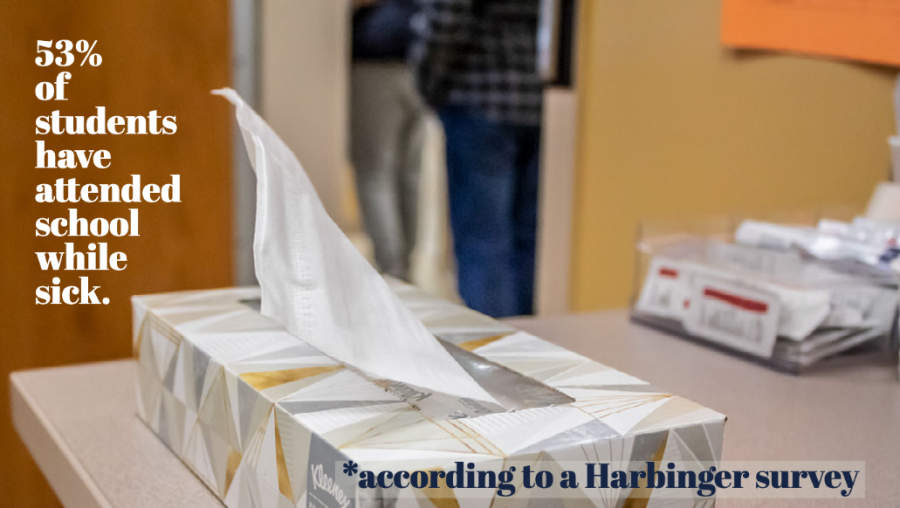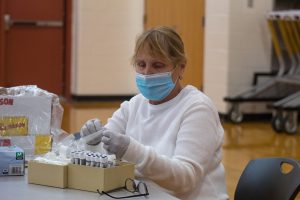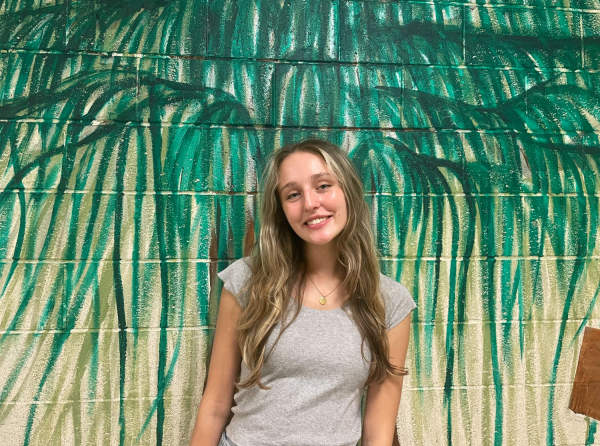When academic pressures meet a pandemic
Spreading sickness leads students to feel reluctant about staying home
February 11, 2022
The ongoing trend of students and teachers attending school when sick, despite the administration’s discouragement, has been impacting the school community because of the continued spread of illness.
The winter season is typically filled with stuffy noses, scratchy voices and coughs from the back of the room, and according to a Harbinger survey of 127 students from Jan. 3 to Jan. 5 through Google Forms, 53% of students have attended school while sick. Especially during the COVID-19 pandemic, attending school while sick can lead to disruptions in the classroom environment and anxiety in the school community, and the spread of illness has led to an increase in restrictions and prolonged mask mandates.
School nurse Heather Allen said that as of Dec. 17, COVID-19, the flu, GI stomach infection, norovirus and strep throat were spreading through the school community. Allen also said the winter season tends to lead to even more infections because of indoor sports and activities. Allen reiterated that sick days are excused if students call the school, and she believes health should be a priority.
“If students don’t take the right precautions like staying home when they’re sick, getting tested and touching base with [the school], then the risk for transmission in the community is higher,” Allen said.
The school administration has tried to prevent students from attending school when they are ill.
“We really try to discourage kids and adults from coming to school when they’re sick because they will likely end up getting somebody else sick, or they could get themselves even sicker,” Principal Sean Bevan said.
According to the Harbinger survey, 52% of students feel worried when students or teachers come to school when sick.
Sophomore Sheila Purcell has expressed anxieties about catching viruses from others at school.
“I think [attending school while sick is] very inconsiderate for people who care about their health and actually want to stay in school,” Purcell said.
Among the 53% of student respondents who said they have attended school with an illness, the fear of missing work and having to make it up was a common sentiment.
“I didn’t think I could miss school without falling behind and getting overwhelmed with work,” one anonymous survey respondent said.
Bevan recognizes the reasoning for why some students attend school when sick..
“I do understand the compulsion for somebody to still come to school [when sick], because they’re worried they’re going to miss something, or it’s going to be hard to keep on top of their studies,” Bevan said. “If they miss a full day, my hope is that teachers are forgiving of that and give them enough time to make up the work.”
English teacher Emily Philbin understands the perceived pressure that drives students to attend school while sick, and even relates to the issue herself. Students aren’t the only members of the ARHS community who feel the pressure to stay in school.
“I would imagine it’s just hard [for students] to make stuff up,” Philbin said. “Even as a teacher, sometimes I [come to school while sick]. It is sometimes easier to come to school than to have to make everything up.”
Math teacher Lauren Hesemeyer has also felt the need to teach when sick due so her students can continue learning.
“There is definitely a pressure for [teachers] to come in to teach when we are sick, even though we don’t feel well, just to avoid the fact that our kids might fall behind,” Hesemeyer said. “A lot of kids tend to not do the work when the teacher is not here, or they try it, but they don’t fully understand it because the teachers are not there to explain.”
The COVID-19 pandemic has presented unique circumstances for students who are required to quarantine if they test positive for the virus, even when they are asymptomatic, which results in a buildup of school work and the absence of direct instruction. Hesemeyer said the remote-learning tools from last year’s hybrid format helped alleviate this problem.
“I really appreciated the fact that we could have kids Zoom-in when they were sick, but this year we were encouraged to just stick to fully in-person teaching,” Hesemeyer said. “I do feel with the increase in COVID cases, it would be beneficial for us to implement an option to Zoom into class.”
However, Philbin believes it is more important for students to recover from illnesses, rather than focus on schoolwork while at home.
“I think it’s a dangerous assumption to tell students that if they’re home sick, they must come to school through the computer anyway,” Philbin said.
Bevan explained the pros and cons to consider if Zoom were re-introduced as an option for remote learning.
“In an ideal world, there would be the ability to Zoom-in a kid who’s sick at home, so that they don’t miss that direct instruction,” Bevan said. “What that does for the teacher is pretty taxing; it requires a lot of effort and setup and it’s not always a great learning product.”
While there may be potential solutions out there, Bevan encourages students and teachers alike to listen to the consistent message from the medical staff for now.
“We are all still in a pandemic, so people really just need to listen to their bodies and stay home when they’re sick,” Allen said.














